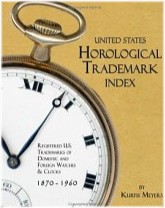United States Horological Trademark Index

United States Horological Trademark Index
Autor: Kurtis Meyer
Seiten: 519
online bestellen:
ISBN 1412017874
ISBN 978-1412017879
Buchbeschreibnung
Trademark Indexes are invaluable research and identification tools, which every collector and researcher who deals with factory made, branded goods wants and needs. For evaluating and appreciating Kurtis Meyers’ book, the first major new book in this category in decades, it however is necessary to digress into horological publishing history. In horology the trademark “bible” has long been Karl Kochmann’s pioneering work “Clock & Watch Trademark Index – European Origin”. First published in the 1970s as a manually compiled listing of a few hundred trademarks on under 100 pages, it grew organically trough the authors lifelong hunt for first hand evidence, and through a global network of correspondents, to the 1000 page sixth edition of 1992, the last produced by Mr. Kochmann himself, who by then was in his 70s. It lists nearly 10’000 trademarks or variants thereof, based on 35’000 observations or data points. Kochmann deserves the eternal gratitude of the horological community for not only introducing most of us to the importance of trademark research, but also for collecting and publishing the data in a time before computers and databases were standard tools of research and publishing. Kochmann's books were produced mostly on a manual typewriter, the image trademarks hand drawn by the author. (The current, hardbound edition of Kochmann has been re-published by a third party, and is essentially a photo-mechanical reproduction of Kochmann's own last edition.) The strength of Kochmann's work relies on its vast diversity of sources, but the process of its creation also is the roots of its limitations: Not all sources were equally reliable and the thoroughness of the fact-checking varied over time, leading to numerous errors and a organizational structure of the final volume that baffles novices, and sometime challenges even longtime users. I doubt there is anybody who would describe that book as “user friendly”. And this is where Kurtis Meyer steps into the picture with his new book. He set out to create a horological trademark index by a process that is diametrically opposed to the one used by Kochmann. The publication aims only to take trademark information from one source and make it easily available to his fellow horologists. The result is a book that looks and feels “clean”, and is easy to use. Myers systematically mined the database of the US Patent and Trademark Office for all horological trademarks – both wordmarks and images – that were registered in this country between 1870 and 1960. In other words it documents “trademarks claimed and issued” (rather than “trademarks observed”) and thereby drastically reduces the “clutter” from all the unregistered trademarks (and variants of registered trademarks) as well as the obscure marks of small overseas makers who never intended to market their timepieces in America, and whose goods are hardly enountered by collectors in this country. The main part of the book is organized alphabetically by registrant. The registrant may be a manufacturer, a “private label” marketer, or a U.S. importer or agent for a foreign based entity. (The main entry includes date of registration and the date protection was grated.) Because of cross indexing organisation by registrant does not present problems, and provides the added benefit of documenting hard to find information on who represented which foreign makers in the US over time. The book shows photographic reproduction of the image and word logos as filed with the authority, and thus avoids the inherent pitfalls of images hand copied from clock plates and redrawn over generations. A book that labels itself an “index” of course is only as good as the indexes that provide alternative ways of getting into the main body of the text. Beside a comprehensive alphabetical index of about 400 entries, the book features a most compact and very useful pictoral index, which makes it very easy to identify picture-only or illegible trademarks. The whole book is well organized, and easy to use even for the casual and novice user. There is no doubt that Myers’ work contains fewer trademarks than Kochman, but it is infinitively easier to use, and it will provide a quick answer to 95%plus of your questions. I predict that this new book will become a standard reference work for the American horological collector and researcher. For those unusual and tricky conundrums the more experienced researcher will certainly also want to keep a copy of Kochmann at hand, but “United States Horological Trademark Index” by Kurtis Meyers is bound to be an indispensable part of any well stocked horological bookshelf. Fortunat Mueller-Maerki (New Jersey) 5 March 2004